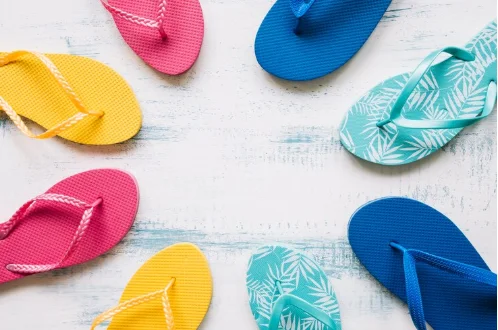Using Wholesale Flip Flops in Disaster Relief: Comfort and Convenience

What’s the first thing you’d grab in an evacuation? Phone? Wallet? Your favorite hoodie?
Shoes don’t usually make the list.
But when you’re standing on a cold gym floor, wearing damp socks and borrowed sweatpants, that oversight hits hard.
That’s the moment a simple item—say, a $2 pair of flip flops—becomes priceless.
Because relief doesn’t always come in a giant truck of canned goods. Sometimes, it shows up in a cardboard box labeled “WHSL FLIP FLOPS – ADULT – 100 CT”.
The Forgotten Essential
Spoiler: People can’t walk barefoot in a disaster zone.
It’s easy to forget how much a single pair of shoes matters—until you don’t have them.
Disasters don’t wait for you to pack sensibly. Whether it’s a flood, wildfire, or hurricane, people flee with whatever they’ve got. And often, “whatever” means sandals with broken straps or literally nothing.
That’s where wholesale flip flops come in. Lightweight. Affordable. Easy to hand out. A soft landing for people walking out of chaos.
Why Bulk Makes Sense (Even If It Sounds Weird)
Okay, you might be thinking: Why flip flops? And why in bulk?
Simple. Because emergencies don’t come in ones and twos—they come in dozens. Hundreds. Sometimes thousands.
And in those moments, relief organizations need gear that checks a few key boxes:
- Cheap, but not flimsy
- Easy to store and ship
- Fits everyone (or close enough)
- Can be distributed without a sizing meltdown
And let’s be real—when it’s an emergency, you don’t have time to pick a color palette.
Hygiene. Health. Humanity.
It’s not just about shoes—it’s about safety.
Flip flops in disaster relief aren’t about style. They’re about sanitation.
People walking around barefoot in shelters, on gymnasium floors, or through muddy streets? It’s a recipe for injuries and infection. Think bacteria, fungi, open wounds… and nowhere near enough medical staff.
A basic pair of flip flops creates a literal barrier between someone and a very contaminated world.
They also restore a bit of dignity. Because no one wants to be barefoot in a public bathroom. Ever.
Who’s Actually Using These Things?
You’d be surprised.
Flip flops are making quiet appearances in:
- Red Cross disaster shelters
- Refugee and migrant camps
- Church mission trips and mobile clinics
- Community centers prepping for fire season
- Hospitals needing quick footwear for discharged patients
They’re the universal donor of the footwear world—no laces, no socks, no fuss. Just grab and go.
And when you’re moving fast, that kind of simplicity isn’t just convenient—it’s critical.
The Dollar Store Lie
Don’t let the price fool you. Quality matters.
Not all flip flops are created equal. The ones you find for a buck at a discount bin? They’ll barely survive a pool day, let alone a flood zone.
Wholesale doesn’t mean cheap and flimsy. The good stuff is:
- Made with durable rubber soles
- Flexible, but supportive
- Designed to hold up under actual use, not just five steps into the backyard
They’re made for walking. And scrubbing. And showering. And standing in food bank lines. Again and again.
Pack Light, But Pack Smart
If you’re part of a nonprofit, a faith-based group, or just a really well-prepared human, having a box of wholesale flip flops in your supply closet might be the move you didn’t know you needed.
They take up almost no space. Cost next to nothing per pair. And in a crisis, they deliver exactly what’s needed: quick comfort, dry feet, and a small moment of control in a very out-of-control world.
The Bottom Line: Big Relief, Small Footprint
Disaster response isn’t all flashlights and first aid kits. Sometimes it’s handing someone their first clean, dry pair of shoes in days.
Wholesale flip flops might not make headlines—but they make an impact. They’re that quiet kind of heroism: practical, affordable, and always ready when needed.
And in the business of helping people feel human again, that’s the kind of gear worth having.
So go ahead—stock the box. Future-you (and future-them) will be glad you did.
Recent Posts
Recent Comments

Understanding Your Customers: The Power of Market Research

Role Of Oven Toaster Grillers In Meal Prepping For Busy Professionals

Which Is the Best Shipping Option from the USA to India: Sea or Air?

How to Blend Home & Gym Workouts: A Balanced Routine for Everyone from Reddit Users

Why Electricians Recommend Upgrading Old Switches and Lights Today

Variance in Finance: How CFOs Can Leverage Analytics Tools for Informed Decision‑Making

Mastering Event Planning: Finding the Perfect Function Space
